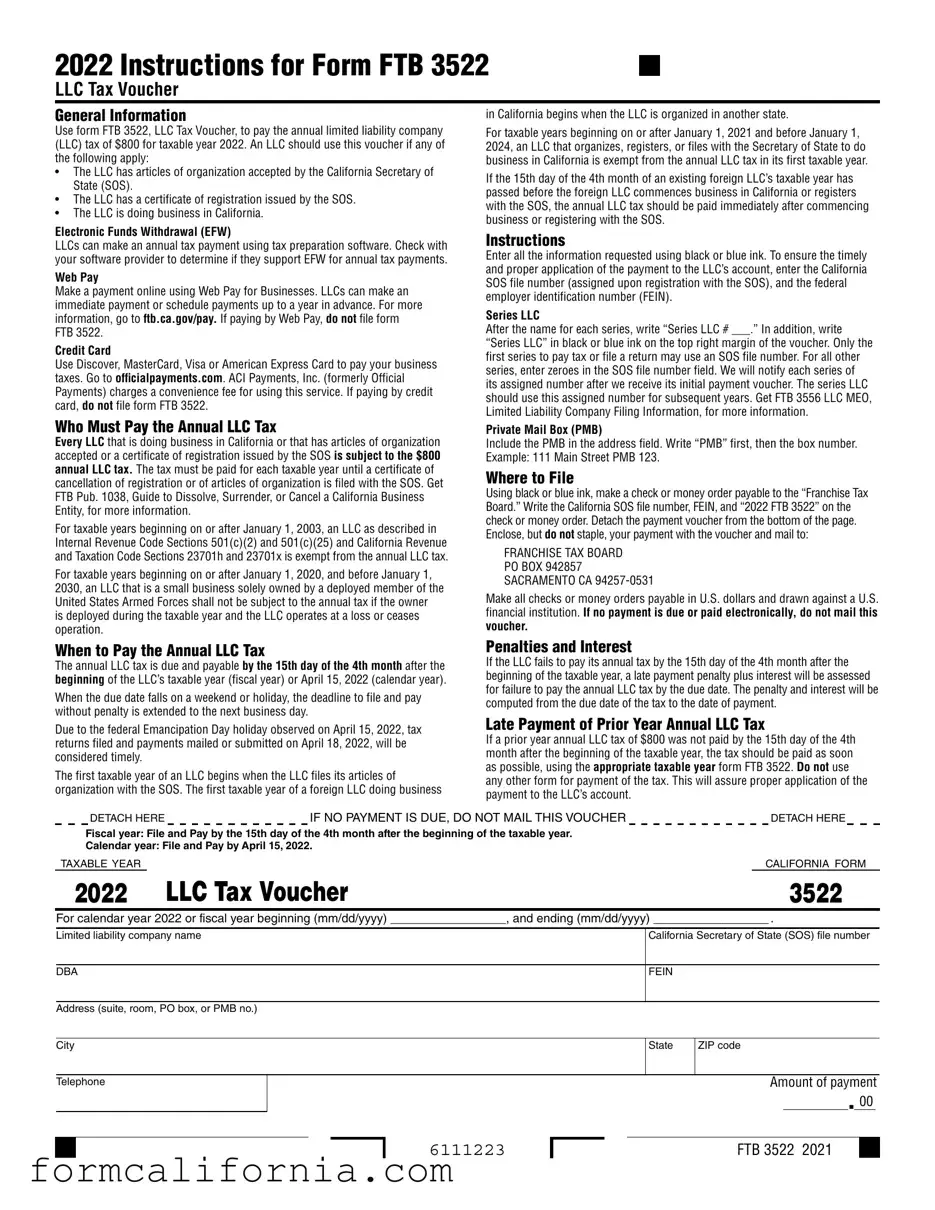The California 3522 form is quite similar to the IRS Form 1065, U.S. Return of Partnership Income. Both documents are used by business entities to comply with taxation requirements, albeit for different tax authorities. Form 1065 is a federal form used by partnerships to report their income, deductions, gains, losses, etc., to the IRS. In contrast, Form 3522 is used by LLCs in California to pay their annual tax to the state. Both forms are essential for businesses to maintain tax compliance in their respective jurisdictions.
Another related document is the California Franchise Tax Board Form 568, Limited Liability Company Return of Income. Similar to Form 3522, Form 568 is also geared towards LLCs in California. However, while Form 3522 is specifically for the payment of the annual LLC tax, Form 568 is more comprehensive, covering income, deductions, and tax liabilities for the respective taxable year. Both documents are essential for LLCs operating in California to fulfill their state tax obligations.
The California Secretary of State Statement of Information (Form LLC-12) is another document with similarities to Form 3522. This form is necessary for LLCs to update or confirm their active status and information (such as addresses, management, etc.) with the California Secretary of State. Although it doesn't involve tax payment, like Form 3522, it's crucial for maintaining an LLC's good standing in the state, demonstrating how various forms collectively uphold an entity’s legal and tax responsibilities in California.
Form 8832, Entity Classification Election, by the IRS, shares a connection with California's Form 3522 as well. Through Form 8832, an entity can elect its classification for federal tax purposes (e.g., as a partnership, corporation, or disregarded entity). This classification affects the entity's federal tax obligations and, indirectly, its state tax obligations in California, which necessitates the filing of Form 3522 for LLCs. Both forms are pivotal in defining a business's tax treatment under federal and state laws.
The Application to Register a Limited Liability Company (LLC) in California is another related form. This form initiates an LLC's formal existence and eligibility to conduct business in California. While not directly a tax form like the 3522, it's a prerequisite for an entity to come into being and subsequently fulfill tax obligations, such as paying the annual LLC tax through Form 3522, underscoring the administrative pathway that leads to tax compliance.
IRS Form 1120, U.S. Corporation Income Tax Return, is used by corporations to comply with federal tax obligations, analogous to how LLCs use Form 3522 in California. Although serving different entities and tax authorities, both forms fulfill a similar role: they report income and calculate taxes owed. Form 1120 deals with federal taxes for corporations, while Form 3522 relates to a specific state tax requirement for LLCs in California.
The California Form 100, Corporation Franchise or Income Tax Return, is the state counterpart to the federal Form 1120 for corporations operating within California. In parallel, LLCs submit Form 3522 to meet specific state tax payments. Whereas Form 100 covers a broader spectrum of reporting income, deductions, and computing tax liability, Form 3522's focus is on fulfilling the annual tax requirement for LLCs, showcasing different forms tailored to various entities’ tax reporting duties in California.
IRS Form 990, Return of Organization Exempt from Income Tax, used by non-profit organizations to report their income, expenses, and activities to the IRS, shares a commonality with Form 3522 in that both are specialized tax forms designated for specific types of entities. Form 3522 applies to LLCs in California for state tax purposes, whereas Form 990 caters to non-profits for federal tax compliance. Each document plays a crucial role in the respective entity’s tax reporting and compliance framework.
California Employment Development Department (EDD) Form DE9, Quarterly Contribution Return and Report of Wages, parallels Form 3522 as both are part of California's tax reporting system, though for different purposes. Form DE9 is crucial for reporting wages paid, and contributions made to state unemployment insurance. Although serving different functions, both forms ensure entities meet their state tax and contribution obligations, highlighting the breadth of compliance requirements businesses face.
Lastly, the IRS Form 2553, Election by a Small Business Corporation, connects to Form 3522 by facilitating a specific tax status (S Corporation) at the federal level, which can influence state tax filings in California. Entities electing S Corporation status with the IRS might have different state tax obligations, affecting how they approach state-specific forms like 3522. Both documents are vital for entities to secure and maintain their desired tax treatment and compliance.

